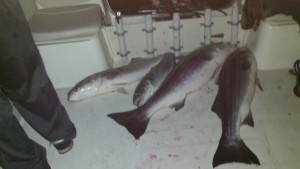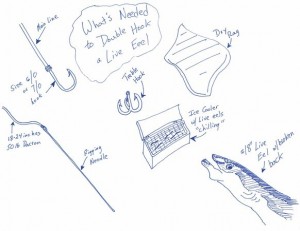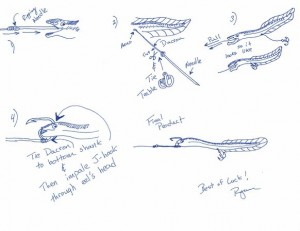One topic which I have received a fair amount of questions and interest on is trolling eels for striped bass. "How to troll live eels" has also been trending a bit in Google searches-which indicates that a reasonable amount of folks (maybe yourself included) have been researching this technique. So despite the arrival of the first stripers of 2012 still a long ways away, I figured now is as good of a time as any to talk about trolling these slimy snakes.

If you happen to have small children on board your boat, have a wife or girlfriend who adores all living creatures, or if you commonly grow emotionally attached to your bait-then I'd recommend not utilizing this technique. I have to be honest with you, trolling eels is not for those with a weak stomach. Rigging up live eels for trolling, or killing eels in preparation of trolling is rather brutal. But this is fishing so I'm assuming most of you are OK with whacking a few eels unconscious.
I like to troll eels using one of two methods.
Method #1 rigs up a live eel with a stinger treble hook threaded through the body of the eel. This is the most time consuming and difficult of the two methods. However the upside of this method is that the eel is still alive as you troll it-granted it has no use of its tail (thus it won't ball up on you).
Take a medium size eel that has been kept directly on ice. The ice won't kill the eel, even if you leave him directly on the ice for an hour or more. What the ice will do is put the eel into a comatose state for a bit, just long enough to rig him up. This makes handling the eel much easier.

Take a rag, grip the eel, and whack him over the head a few times. Then cover the mid section of the eel with a dry rag, get a grip on the midsection with a pair of pliers, and pop the vertebrae in the eels back/tail. If done correctly the eel will still be alive, yet the eel will not be able to move its tail, thus preventing those nasty eel balls.
Utilizing a rigging needle or "jury rigged" piece of wire, tie a two foot section of 50 or 60 pound monofilament to the eye of the rigging needle. Run the needle and the mono through the mouth and out the anus of the eel. Cut the mono and tie a stinger hook to the end of the mono exiting the eel's anus. Cut the mono down and tie the other end to the bend in a live bait hook. Hook the live bait hook through the eel's head.
The finished eel should be hooked through the head by the live bait hook. The stinger hook mono should run through the body of the eel, and the stinger hook should dangle close to the tail of the eel.
Method #2 is easier, less time consuming, and bit more bearable for the squeamish people aboard your boat. You first need to have an ample supply of dead eels ready for rigging. Maybe these are eels that you were casting earlier in the day that have now expired. If you find yourself with only live eels, then you are going to have to expedite the eels' expiration. This can be done by suffocating the eels in a plastic bag, or repeatedly whacking the eel over the head. Again, a method not for the faint of heart.

Take a live bait hook and tie it to your main line. Next tie a treble stinger hook to the bend of the live bait hook. Use 50 or 60 pound monofilament for the connection. If the eel is 12 inches in length, make the stinger hook connection about 8 inches long. This way you have a live bait hook in the eel's head, and a treble stinger hook dangling down by the eel's tail.
Since the eel is dead you don't have to worry about threading the stinger hook line through the body of the eel.
When trolled the eel should swim in a straight line. If the eel spins through the water, make adjustments until the eel swims straight. Also be sure to check the stinger hook connection line for any fray, nicks or abrasions. With a fish on there will be a great deal of pressure exerted on this small segment of line, and it will break under pressure if line fray develops.
Good luck live eeling!


How fast should a troll using this method?
I’ve had success trolling between 1mph-2.5mph. LMK if I can help answer anything else. Thanks Aaron!